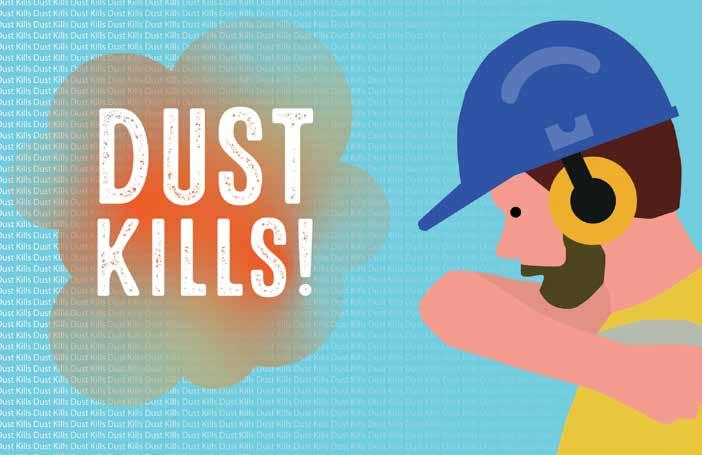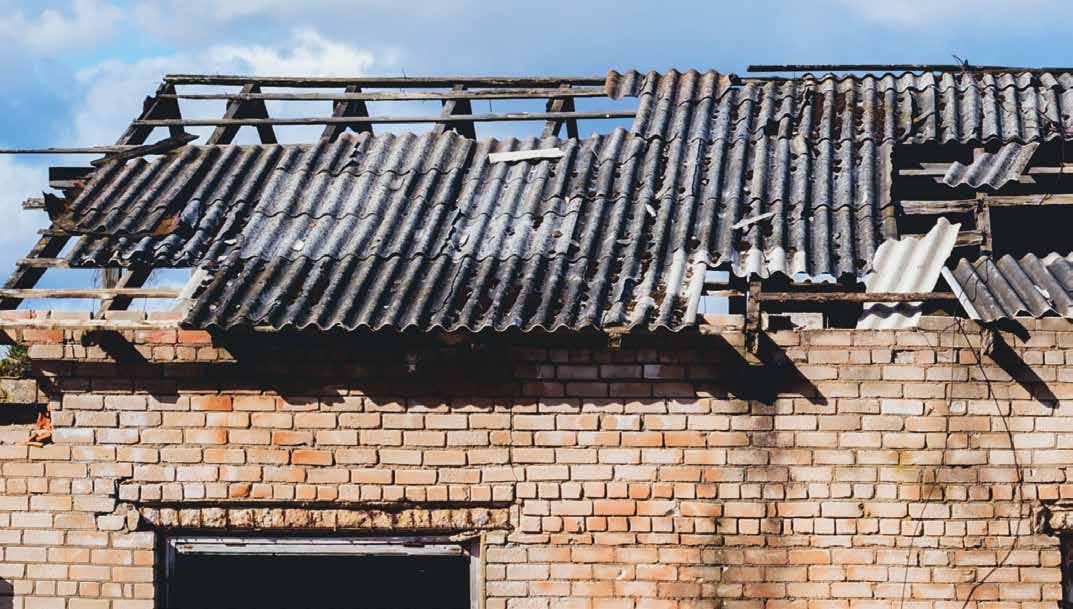
7 minute read
Asbestos in the news
21 September 2021 https://press.hse.gov.uk/2021/09/21/health-and-safety-executive-cracks-down-hard-on-dust/
Dust Kills -
HSE cracks down hard on dust
During October HSE’s inspectors across Great Britain targeted construction firms to check that their health standards are up to scratch, focusing on respiratory risks and occupational lung disease.
This is part of HSE’s longer term health and work strategy to improve health within the construction industry.
HSE looked at the control measures businesses have in place to protect their workers’ lungs from construction dust including silica, asbestos and wood dust.
While the primary focus was on health during this programme of inspections, if an inspector identified any other areas of concern, including immediate safety risks, they took the necessary action to deal with them.
Inspectors were looking for evidence of employers and workers knowing the risks, planning their work and using the right controls. If necessary, they would use enforcement to make sure people are protected.
More than 3,500 builders die each year from cancers related to their work, with thousands more cases of ill-health and working days lost.
HSE’s chief inspector of construction, Sarah Jardine, said: “Around 100 times as many workers die from diseases caused or made worse by their work than are actually killed in construction accidents.
“Our inspection initiatives ensure that inspectors are able to speak to duty holders and visit sites to look at the kind of action businesses in the construction industry are taking right now to protect their workers’ health, particularly when it comes to exposure to dust and damage to lungs. These are mature health challenges that the industry ought to be managing effectively.“
11 October 2021 https://press.hse.gov.uk/2021/10/11/construction-company-fined-for-employee-asbestos-exposure/
Construction company fined for employee asbestos exposure
MS Properties (Northern) Ltd have been fined for safety breaches after employees were exposed to asbestos on 22 March 2019 after removing false ceiling tiles during a shop conversion at 309-315 Hessle Road, Hull.
Beverley Magistrates’ Court heard that the company had not commissioned a refurbishment asbestos survey prior to the work commencing. Employees removed over 1000m2 of asbestos insulation board (AIB) ceiling tiles in an uncontrolled manner, exposing them to asbestos.
An investigation by the Health and Safety Executive (HSE) found that the company’s director, and the casual labourers they employed, spent approximately three to four weeks removing the suspended ceiling, along with the ceiling tiles which contained asbestos, to install new stud walls to divide the shop floor into separate units. The labourers were unskilled and untrained. They were provided with a claw hammer to knock the tiles down. The asbestoscontaining tile debris was then shovelled or collected into approximately 62 one tonne bags.
MS Properties (Northern) Limited of Beckside Business, Beckside Road, Bradford, pleaded guilty to breaching Regulation 5 of the Control of Asbestos Regulations 2012. The company has been fined £16,000, ordered to pay £3,011.87 in costs and a victim surcharge of £190.
After the hearing, HSE inspector Trisha Elvy commented: “If the company had identified any asbestos on the site through a refurbishment asbestos survey, carried out by a competent surveyor, and had it removed by licenced asbestos removal contractors prior to the refurbishment work commencing, then MS Properties (Northern) employees would not have been exposed to asbestos.
“No matter how small or large your company, there is a need to prevent exposing your employees and the public to asbestos by ensuring that it is identified on site prior to any work commencing.”

Packaging & Transporting Asbestos Cement Sheets for Disposal

All asbestos waste is defined as ‘hazardous waste’ in England and Wales and as ‘special waste’ in Scotland when it contains more than 0.1% asbestos. The corresponding waste legislation is therefore subject to enforcement by the Environment Agency, Natural Resources Wales, or the Scottish Environment Protection Agency, as the case may be.
Waste containing asbestos must be consigned under the relevant waste Regulations which include a “duty of care”. That duty of care means, amongst other things, that duty holders prevent escape of the waste whilst it is in their control.
All movements must be accompanied by a hazardous/special waste consignment note. The Control of Asbestos Regulations 2012 (CAR 2012) also apply.
Under ADR (The European Agreement concerning the International Carriage of Dangerous Goods by Road), some asbestos products are covered by ADR Special Provision 168 (SP 168) and are totally exempt from compliance with ADR and the Carriage of Dangerous Goods and Use of Transportable Pressure Equipment Regulations 2009 (CDG), as they are not regarded as dangerous for carriage, although the Hazardous or Special Waste regulations and CAR 2012 still apply. The exemption applies to waste which is either bound in cement, plastic, or another binder so that fibres cannot escape during carriage, or manufactured articles containing asbestos. Examples include asbestos cement sheets, drainpipes or vinyl floor tiles.
Packaging of large Asbestos Cement sheets
Packaging for large asbestos cement (AC) sheets needs to have an Asbestos ‘a’ warning label in accordance with REACH (Registration, Evaluation, Authorisation and Restriction of Chemicals) Annex XVII, Appendix 7. There is a requirement to alert people that the package contains asbestos.
For example, large AC sheets could be wrapped in polythene with an asbestos label applied, or a UN asbestos bag could be used as this has an Asbestos ‘a’ warning label on it.
As AC roof sheets are a manufactured article, and therefore if they are damaged or have the potential to be damaged during carriage, they are still not subject to the requirements of ADR as SP 168 applies, providing they are packed so that no asbestos fibres can escape during carriage.
There is no guidance within ADR as to what this packaging should look like, therefore CAR 2012 needs to be referred to.

The Control of Asbestos Regulations 2012 states: (1) Every employer who undertakes work with asbestos must ensure that raw asbestos or waste which contains asbestos is not (a) stored (b) received into or despatched from any place of work, or (c) distributed within any place of work, except in a totally enclosed distribution system, unless it is in a sealed receptacle or, where more appropriate, sealed wrapping, clearly marked in accordance with paragraphs (2) and (3) showing that it contains asbestos.
The Approved Code of Practice (ACoP) accompanying CAR 2012 provides guidance on how to package large items of waste such as AC: w 529 – Wherever practicable, large items of rigid ACM such as sheets of asbestos cement and textured coatings attached to a board should not be broken up or cut down for disposal in plastic sacks. w 530 – The intact rigid waste should be double wrapped in suitable polythene sheeting (1000 gauge or equivalent) or other suitable material and labelled accordingly. w 531 – If the asbestos waste is not to be disposed of immediately, the wrapped package should be placed in a suitable and clearly labelled sealed receptacle, such as a lockable skip or freight container.
In summary
CAR 2012 requires the employer to prevent or minimise exposure and spread of asbestos fibres, this includes handling, transportation, and final disposal.
What does this mean for large quantities of intact AC roof sheets: w Must not be broken up for the purposes of waste disposal w Must be protected from damage during transport which could cause further spread (secured, contained in a metal skip or lorry with metal side panels to protect on 3 sides), w Spread of fragments and dust must be minimised – either double wrapping individually in 1000 gauge polythene or placing in a suitable bag or a polythene lined skip or lorry. w Should be taken to a licensed waste facility. l If going to a waste transfer station,
AC sheets must be double wrapped in polythene or other suitable material, as people will be handling them. l If going straight to landfill, then the vehicle needs to be suitable to transport and tip at the face of the landfill – polythene lined skips and lorries are accepted, but waste must not be handled by operatives, it must be tipped in accordance with the site rules and procedures.
Note: a flatbed lorry would not be considered suitable as it provides no physical protection to the secured load at the sides, as provided by a skip or tipper truck.










